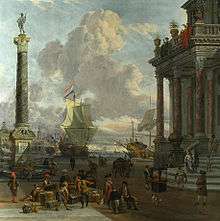Trade diversion
| Part of a series on |
| World trade |
|---|
 |
Trade diversion is an economic term related to international economics in which trade is diverted from a more efficient exporter towards a less efficient one by the formation of a free trade agreement or a customs union.
Occurrence
When a country applies the same tariff to all nations, it will always import from the most efficient producer, since the more efficient nation will provide the goods at a lower price. With the establishment of a bilateral or regional free trade agreement, that may not be the case. If the agreement is signed with a less-efficient nation, it may well be that their products become cheaper in the importing market than those from the more-efficient nation, since there are taxes for only one of them. Consequently, after the establishment of the agreement, the importing country would acquire products from a higher-cost producer, instead of the low-cost producer from which it was importing until then. In other words, this would cause a trade diversion.
Term
The term was coined by Jacob Viner in The Customs Union Issue in 1950. In its literal meaning the term was however incomplete, as it failed to capture all welfare effects of discriminatory tariff liberalization, and it was not useful when it came to non-tariff barriers. Economists have however dealt with this incompleteness in two ways. Either they stretched the original meaning to cover all welfare effects, or they introduced new terms like trade expansion or internal versus external trade creation.
Viner's article became and still is the foundation of the theory of international economic integration. It considered only two states comparing their trade flows with the rest of the world after they abolish customs tariffs on inner border of their union. Following the fact that economic unions most often include more than 2 states, attempts have been made to increase the number of the states (3+world), but not so successfully, as they did not have as clear conclusions as Viner's.
Opposite to economically efficient trade creation effect, the trade diversion flow is cost-inefficient compared with the rest of the world. Balance between trade creation and trade diversion effects due to the creation of economic union makes the union either economically efficient (positive balance) or inefficient (negative balance). It is based on the fact that unification of states usually applies mergers of more than 1 sector in economy (even European Coal and Steel Union, which had 2 sectors only) leading to the creation of either trade creation or diversion effects.
Positive effects of trade diversion include increase of trade between unified states, increase of employment in manufacturing states inside the union consequently leading to increase of respective taxes and welfare.
Downside
Diverted trade may hurt the non-member nation economically and politically, and create a strained relationship between the two nations. The decreased output of the good or service traded from one nation with a high comparative advantage to a nation of lower comparative advantage works against creating more efficiency and therefore against more overall surplus. It is widely believed by economists that trade diversion is harmful to consumers. The dynamics of trade diversion was described by Ravshanbek Dalimov in 2009. He used similarity of trade flows to the flux of gas or liquid stimulated by the pressure difference, while the flows of trade flows are stimulated by the price difference. This allowed use of Navier-Stokes equations for the interregional dynamics of trade flows.
Example
An example of trade diversion is the UK's import of lamb. Before Britain joined the EU, most lamb imports came from New Zealand, the cheapest lamb producer. However, when Britain joined the EU the common external tariff made it more expensive to import lamb from New Zealand than from countries inside the union, thus France became the majority exporter of lamb to the UK. Trade was diverted from New Zealand and created between France and the UK.
See also
External links
- Trade creation and diversion
- Trade Diversion: Commentary on development, globalization, and trade by Jonathan Dingel
- Pablo Velazquez
- http://www.maxwellsci.com; The dynamics of trade creation and diversion effects under international economic integration. Ravshanbek Dalimov. Current Research Journal of Economic Theory, 2009, vol. 1. An article proposes to use similarity between dynamics of gas and liquid moving under pressure difference, and the dynamics of trade flows (output) moved under price difference. This allowed to use Navier-Stoxes equation applied for the dynamics of gas and liquid towards the dynamics of trade flows.